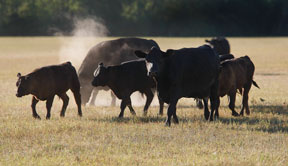Drought has potential three-year 'tail' on beef production
July 3, 2012
 |
|
Without proper nutrition and pasture management in a drought year, beef herd performance can suffer for years to come. (Purdue Animal Science photo/Ron Lemenager) |
WEST LAFAYETTE, Ind. – Livestock producers who fail to properly manage the drought could find themselves dealing with the consequences long after the rains return, says a Purdue Extension beef specialist.
Exceptionally high temperatures and extremely low rainfall have combined to stress livestock and reduce their feed supplies. Producers can take steps to manage a situation that might cost some money now but could pay off in big ways in the long run.
"The tail on this can be pretty long if we don't manage things right in a drought year," Ron Lemenager said. "One thing that I think is really important for producers to consider this year is body condition. If you use condition scores of these cows as a barometer of where you're at nutritionally, we can't do much about the heat or drought, but we can make sure we don't have any nutritional deficiencies."
In a drought year, forages are low in both quality and quantity, which can leave cows thin and undernourished. Less-than-optimal body conditions can have reproductive consequences not only this year, but next year as well.
Heat stress coupled with poor nutrition can create a double whammy by lowering oocyte and sperm quality, as well as embryo survival if fertilization does occur, Lemenager said.
"The environmental conditions we are experiencing have ratcheted stress forward into the heart of the breeding season for those that calve in the spring, meaning it's very probable we'll see more open cows than normal this fall," he said.
Lemenager said the likely increase in open cows this year means producers need to pregnancy-check cows to minimize the use of expensive feeds. When forages are in short supply, there is little reason for producers to feed non-productive animals. Instead, they can consider marketing culled cows earlier than normal to take advantage of higher market prices.
"If we're short on forage we have the option of sliding by, but if cows are thin going into the fall, fewer will be bred, calves will be lighter at weaning time this year and fewer calves will be born next year," Lemenager said. "Then, if cows are thin heading into next breeding season, fewer cows will be bred and colostrum quality will be lower, meaning a lower calf survival rate which affects productivity in years two and three."
To avoid the three-year "tail," he said producers might need to pay the price now to supplement feed and make sure cows are healthy and in moderate body condition. Healthy cows will breed better and can shorten the time producers face fallout from the drought.
In addition to monitoring body condition, Lemenager and Purdue Extension forage specialist Keith Johnson offered producers a list of steps they can take to manage drought and heat stress:
* Avoid overgrazing and employ rotational grazing.
* Creep-feed calves to create near normal weaning weights.
* Early-wean calves to take pressure off of both cows and pastures.
* Identify and manage poisonous plants in pastures and hay fields.
* Establish summer annuals to increase late-season forage production.
* Pregnancy-check and market cull cows earlier than normal to reduce feed needs.
* Inventory hay and other feed resources.
* Analyze feeds for nutrient profiles to help determine supplemental feed needs.
* Use alternative feeds to supplement and stretch forage supplies.
* Limit hay access time to stretch forage supplies.
* Limit-feed a high-concentrate diet to stretch forage supplies.
* Graze crop residues and stockpiled forages to reduce harvested feed needs.
* Use drought-stressed corn for grazing, green chop or silage.
* Make sure cattle have access to a clean, cool water supply.
* Moisten the soil around ground rods of electric fences.
More detailed information about each of these steps, including sample diet formulations, can be found in Lemenager and Johnson's publication, "Beef Management Practices for Coping With a Short Forage Supply" on the Purdue Animal Sciences Beef Center website at http://www.thebeefcenter.com. Click on "Dealing with Drought" on in the left column.
Other Purdue Extension drought-related resources are available at http://www.agry.purdue.edu/ext/corn/cafe/drought/index.html
Writer: Jennifer Stewart, 765-494-6682, jsstewar@purdue.edu
Source: Ron Lemenager, 765-494-4817, rpl@purdue.edu
Ag Communications: (765) 494-2722;
Keith Robinson, robins89@purdue.edu
Agriculture News Page

